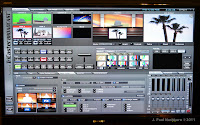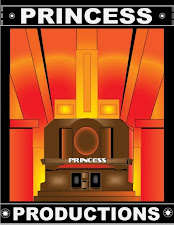Bill Radice, who is currently operating the Channel 15 Television Station in Harriman, is a guest blog poster this week. In this post, Bill describes the Typical Job Titles normally found within the organization of a traditional television studio. These are the type jobs that students from our area will be filling in the coming months.
1. Technical director: Usually called the “TD”. This is the person who runs the control panel that switches all the cameras, playback devices, and graphics titles that make up what the viewer sees. If the program is being recorded, as is often the case, the TD serves the same function except the video will be edited later on by the “Editor” who is sometimes, but not often, the TD himself. The process of working on the assembly of the final production is referred to as “post production”. The TD will always take his orders from the “Director”….if there is one. The TD has one of the most difficult jobs in a TV environment because they must take orders and execute them quickly and perfectly, especially if a program is “live”. This is why very few programs are done live-to-air. Live sporting events are the pinnacle of achievement for a TD. The complexity of a show is measured by counting the number of events on screen in one minute. In a sporting event, this can be as many as 20. Multiply that by a two hour event and the TD is exhausted; but surely one of the most important jobs in the studio!
2. Director: This is the person who actually makes the decision as to what is shown on the screen. The director selects the camera, the graphics, and every element that goes into the production.
The director calls all the shots in a TV studio, and works very closely with the TD. Ultimately the director is responsible for the entire “look” of what the viewer sees. Once again a live sports event is the most demanding job that a director can do.
3. Graphics: This person constructs all the “extras” that are put on the screen. This includes the title boxes you see on the bottom of the screen, the moving things, the scrawling text, and almost everything besides the actual camera shot itself. The Director will call for the graphics person to have the item ready for his use, or often the graphics are loaded into the system in advance, once again following the script, if there is one. Only the best graphics people can actually compose these items “on-the-fly”. The graphics are almost always composed in advance of the show, and then stored in the system for instant recall later during the show.
4. Sound Engineer: Sometimes in a small production, the sound can be handled by the TD himself, but if there are several microphones and sound sources it can be very important to have a separate person to handle this. The sound engineer, if he’s a good one, will control the sound in a way that makes everything clear and professional sounding. This involves constantly controlling the microphones that are fed to the program, as well as mixing the sounds to compliment whatever is on the screen. Typically in outdoor shots, the sound is not recorded live but added later. The sound of a passing car will be added from a stock recording, and the actors will record everything they say outdoors, separately, in a quiet studio. By doing this there is much more control over unwanted sounds. This makes the sound engineer’s job very complicated. The next time you hear a truck passing by in a production; it may be the same one you heard in another video!
5. Camera Operator: A camera operator actually moves the camera, either on a tripod, or hand holding a camera or camcorder. Camcorders are used only in the field and the recording is captured on tape, or memory card to later be edited into a production. Remote controlled studio cameras are the norm these days. A single operator can operate many cameras simultaneously with all shots “memorized” into a controller that can often run 10 cameras, each with 50 shots memorized for the particular production, in a procedure called “blocking the shots”. Modern digital cameras do not require the constant adjustment needed in the past. In a live video production the director will communicate via earphones to all the camera operators simultaneously, telling them, by camera number, what to shoot. Then he will announce in their earphones when he has “taken” their camera. This is so the operator will know he has a “live” camera and not to move his shot.
6. Producer: This is the person who puts the entire production together. He picks the story, the talent, the studio, all the people involved in the project work for the producer during the production. Often he finances everything.
7. Editor: Most television productions are not done live. The program is shot in many segments, often out of sequence to the story. Assembling all the pieces into a coherent final product is the job of the video editor. The editor will work very closely with the director, and the producer, to piece together both the picture and sound. Often the job will be done over and over until everyone is satisfied. The editor is a true “artist” and is able to change the entire look, and pace of the production.
________________________
I don’t know about you, but these positions sound very exciting! If I were a younger person, I’d be down there right now begging someone to let me learn how things work!
Hopefully, in the coming weeks I’ll have other “guest posters” describing other exciting things about the Princess Complex Project. Stay tuned!





















.jpg)




